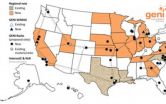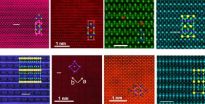(Press-News.org) The National Science Foundation (NSF) today announced two $10 million projects to create cloud computing testbeds--to be called "Chameleon" and "CloudLab"--that will enable the academic research community to develop and experiment with novel cloud architectures and pursue new, architecturally-enabled applications of cloud computing.
Cloud computing refers to the practice of using a network of remote servers to store, manage and process data, rather than a local server or a personal computer. In recent years, cloud computing has become the dominant method of providing computing infrastructure for Internet services.
While most of the original concepts for cloud computing came from the academic research community, as clouds grew in popularity, industry drove much of the design of their architecture. Today's awards complement industry's efforts and will enable academic researchers to experiment and advance cloud computing architectures that can support a new generation of innovative applications, including real-time and safety-critical applications like those used in medical devices, power grids, and transportation systems.
These new projects, part of the NSF CISE Research Infrastructure: Mid-Scale Infrastructure - NSFCloud program, continue the agency's legacy of supporting cutting-edge networking research infrastructure.
"Just as NSFNet laid some of the foundations for the current Internet, we expect that the NSFCloud program will revolutionize the science and engineering for cloud computing," said Suzi Iacono, acting head of NSF's Directorate for Computer and Information Science and Engineering (CISE). "We are proud to announce support for these two new projects, which build upon existing NSF investments in the Global Environment for Network Innovations (GENI) testbed and promise to provide unique and compelling research opportunities that would otherwise not be available to the academic community."
Chameleon
The first of the NSFCloud projects will support the design, deployment and initial operation of "Chameleon," a large-scale, reconfigurable experimental environment for cloud research, co-located at the University of Chicago and The University of Texas at Austin.
Chameleon will consist of 650 cloud nodes with 5 petabytes of storage. Researchers will be able to configure slices of Chameleon as custom clouds using pre-defined or custom software to test the efficiency and usability of different cloud architectures on a range of problems, from machine learning and adaptive operating systems to climate simulations and flood prediction.
The testbed will allow "bare-metal access"--an alternative to the virtualization technologies currently used to share cloud hardware, allowing for experimentation with new virtualization technologies that could improve reliability, security and performance.
"Like its namesake, the Chameleon testbed will be able to adapt itself to a wide range of experimental needs, from bare metal reconfiguration to support for ready made clouds," said Kate Keahey, a scientist at the Computation Institute at the University of Chicago and principal investigator for Chameleon. "Furthermore, users will be able to run those experiments on a large scale, critical for big data and big compute research. But we also want to go beyond the facility and create a community where researchers will be able to discuss new ideas, share solutions that others can build on or contribute traces and workloads representative of real life cloud usage."
One aspect that makes Chameleon unique is its support for heterogeneous computer architectures, including low-power processors, general processing units (GPUs) and field-programmable gate arrays (FPGAs), as well as a variety of network interconnects and storage devices. Researchers can mix-and-match hardware, software and networking components and test their performance. This flexibility is expected to benefit many scientific communities, including the growing field of cyber-physical systems, which integrates computation into physical infrastructure. The research team plans to add new capabilities in response to community demand or when innovative new products are released.
Other partners on the Chameleon project (and their primary area of expertise) are: The Ohio State University (high performance interconnects), Northwestern University (networking) and the University of Texas at San Antonio (outreach).
CloudLab
The second NSFCloud project supports the development of "CloudLab," a large-scale distributed infrastructure based at the University of Utah, Clemson University and the University of Wisconsin, on top of which researchers will be able to construct many different types of clouds. Each site will have unique hardware, architecture and storage features, and will connect to the others via 100 gigabit-per-second connections on Internet2's advanced platform, supporting OpenFlow (an open standard that enables researchers to run experimental protocols in campus networks) and other software-defined networking technologies.
"Today's clouds are designed with a specific set of technologies 'baked in', meaning some kinds of applications work well in the cloud, and some don't," said Robert Ricci, a research assistant professor of computer science at the University of Utah and principal investigator of CloudLab. "CloudLab will be a facility where researchers can build their own clouds and experiment with new ideas with complete control, visibility and scientific fidelity. CloudLab will help researchers develop clouds that enable new applications with direct benefit to the public in areas of national priority such as real-time disaster response or the security of private data like medical records."
In total, CloudLab will provide approximately 15,000 processing cores and in excess of 1 petabyte of storage at its three data centers. Each center will comprise different hardware, facilitating additional experimentation. In that capacity, the team is partnering with three vendors: HP, Cisco and Dell to provide diverse, cutting-edge platforms for research. Like Chameleon, CloudLab will feature bare-metal access. Over its lifetime, CloudLab is expected to run dozens of virtual experiments simultaneously and to support thousands of researchers.
Other partners on CloudLab include Raytheon BBN Technologies, the University of Massachusetts Amherst and US Ignite, Inc.
Each team is led by researchers with extensive experience deploying experimental cloud computing systems. Ricci and the CloudLab team have successfully operated Emulab since 2000, providing a network testbed where researchers can develop, debug and evaluate their systems in a wide range of environments. The Chameleon team includes several members of FutureGrid, an NSF-supported testbed that lets researchers experiment in the use and security of grids and clouds.
Ultimately, the goal of the NSFCloud program and the two new projects is to advance the field of cloud computing broadly. The awards announced today are the first step in meeting this goal. They will develop new concepts, methods and technologies to enable infrastructure design and ramp-up activities and will demonstrate the readiness for full-fledged execution. In the second phase of the program, each cloud resource will become fully staffed and operational, fulfilling the proposed mission of serving as a testbed that is used extensively by the research community.
INFORMATION: END
Enabling a new future for cloud computing
NSF awards $20 million to two new testbeds to support cloud computing applications and experiments
2014-08-21
ELSE PRESS RELEASES FROM THIS DATE:
NASA scientists watching, studying Arctic changes this summer
2014-08-21
VIDEO:
In this animation, the Earth rotates slowly as the Arctic sea ice advances over time from March 21, 2014 to August 3, 2014.
Click here for more information.
As we near the final month of summer in the Northern Hemisphere, NASA scientists are watching the annual seasonal melting of the Arctic sea ice cover. The floating, frozen cap that stretches across the Arctic Ocean shrinks throughout summer until beginning to regrow, typically around mid-September.
As of Aug. 19, ...
Extracorporeal support can significantly increase number of organs for transplant
2014-08-21
Ann Arbor, Mich. — Using heart-lung support technology, the University of Michigan's Transplant Center was able to increase the number of kidneys, livers and pancreases available for transplant by about 20 percent.
The results were published in the journal Transplantation and detail the impact of more than 10 years of using Extracorporeal Membrane Oxygenation, or ECMO, to improve the quality and viability of organs donated after circulatory determination of death.
"Organ transplant is limited by the number of donated organs available, so the use of organs that are donated ...
Liberal democracy is possible in Muslim-majority countries
2014-08-21
A new study by University of Toronto and University of Tübingen researchers suggests that Islam is not as much of an impediment to liberal democracy as is often thought.
"One of the key markers for a successful liberal democracy is a high degree of social tolerance," says U of T sociologist Robert Andersen. "We wanted to see the extent to which this existed in countries with a majority of Muslims compared to Western countries."
Andersen, U of T sociologist Robert Brym and Scott Milligan of the University of Tübingen used data from the World Values Survey – a global ...
Canola genome sequence reveals evolutionary 'love triangle'
2014-08-21
Athens, Ga. – An international team of scientists including researchers from the University of Georgia recently published the genome of Brassica napus—commonly known as canola—in the journal Science. Their discovery paves the way for improved versions of the plant, which is used widely in farming and industry.
Canola is grown across much of Canada and its native Europe, but the winter crop is increasingly cultivated in Georgia. Canola oil used for cooking is prized for its naturally low levels of saturated fat and rich supply of omega-3 fatty acids, but the plant is ...
Despite a significant reduction in smog-producing toxins, the Greater Toronto Area still violates Canada's standards for ozone air pollution
2014-08-21
Despite a significant reduction in smog-producing toxins in past decade, GTA still violates Canada's ozone standards
A new study shows that while the Greater Toronto Area (GTA) has significantly reduced some of the toxins that contribute to smog, the city continues to violate the Canada-wide standards for ozone air pollution.
Smog, which can cause or aggravate health problems such as asthma, emphysema and chronic bronchitis, is produced by a set of complex photochemical reactions involving volatile organic compounds (VOCs), nitrogen oxides and sunlight, which form ground-level ...
Orgasm rates for single women less predictable than men's, vary by sexual orientation
2014-08-21
BLOOMINGTON, Ind. -- A new study of American singles found that during sex with a familiar partner, men have the highest orgasm rates. On average, men experience orgasm 85.1 percent of the time, with their sexual orientation making little difference. For women, however, orgasm occurrence is less predictable. On average, women experience orgasm 62.9 percent of the time during sex with a familiar partner -- and this pattern varies with women's sexual orientation, with lesbian women experiencing orgasm more often than heterosexual or bisexual women.
The Indiana University ...
Losing weight lowers health care costs for adults with type 2 diabetes
2014-08-21
WINSTON-SALEM, N.C. – Aug. 21, 2014 – Overweight individuals with diabetes who lose weight by dieting and increasing their physical activity can reduce their health care costs by an average of more than $500 per year, according to a new study.
"Lifestyle interventions promoting weight loss and physical activity are recommended for overweight and obese people with Type 2 diabetes to improve their health," said Mark A. Espeland, professor of public health sciences at Wake Forest Baptist Medical Center and lead author of the study. "This is the first study to show that weight ...
ORNL scientists uncover clues to role of magnetism in iron-based superconductors
2014-08-21
OAK RIDGE, Tenn., Aug. 21, 2014—New measurements of atomic-scale magnetic behavior in iron-based superconductors by researchers at the Department of Energy's Oak Ridge National Laboratory and Vanderbilt University are challenging conventional wisdom about superconductivity and magnetism.
The study published in Advanced Materials provides experimental evidence that local magnetic fluctuations can influence the performance of iron-based superconductors, which transmit electric current without resistance at relatively high temperatures.
"In the past, everyone thought ...
When it comes to how pizza looks, cheese matters
2014-08-21
CHICAGO—Most consumers have an idea what they want their pizza slice to look like. Golden cheese with that dark toasted-cheese color scattered in distinct blistery patches across the surface with a bit of oil glistening in the valleys. A new study in the Journal of Food Science, published by the Institute of Food Technologists (IFT), evaluated the pizza baking performance of different cheeses (mozzarella, cheddar, colby, Edam, Emmental, Gruyere, and provolone) in conjunction with a new quantifiable evaluation technique to see how their composition and functional differences ...
Ice cream goes Southern, okra extracts may increase shelf-life
2014-08-21
CHICAGO -- While okra has been widely used as a vegetable for soups and stews, a new study in the Journal of Food Science, published by the Institute of Food Technologists (IFT), shows how okra extracts can be used as a stabilizer in ice cream.
Ice cream quality is highly dependent on the size of ice crystals. As ice cream melts and refreezes during distribution and storage, the ice crystals grow in size causing ice cream to become courser in texture which limits shelf life. Stabilizers are used to maintain a smooth consistency, hinder melting, improve the handling properties, ...
LAST 30 PRESS RELEASES:
Mental trauma succeeds 1 in 7 dog related injuries, claims data suggest
Breastfeeding may lower mums’ later life depression/anxiety risks for up to 10 years after pregnancy
Study finds more than a quarter of adults worldwide could benefit from GLP-1 medications for weight loss
Hobbies don’t just improve personal lives, they can boost workplace creativity too
Study shows federal safety metric inappropriately penalizes hospitals for lifesaving stroke procedures
Improving sleep isn’t enough: researchers highlight daytime function as key to assessing insomnia treatments
Rice Brain Institute awards first seed grants to jump-start collaborative brain health research
Personalizing cancer treatments significantly improve outcome success
UW researchers analyzed which anthologized writers and books get checked out the most from Seattle Public Library
Study finds food waste compost less effective than potting mix alone
UCLA receives $7.3 million for wide-ranging cannabis research
Why this little-known birth control option deserves more attention
Johns Hopkins-led team creates first map of nerve circuitry in bone, identifies key signals for bone repair
UC Irvine astronomers spot largest known stream of super-heated gas in the universe
Research shows how immune system reacts to pig kidney transplants in living patients
Dark stars could help solve three pressing puzzles of the high-redshift universe
Manganese gets its moment as a potential fuel cell catalyst
“Gifted word learner” dogs can pick up new words by overhearing their owners’ talk
More data, more sharing can help avoid misinterpreting “smoking gun” signals in topological physics
An illegal fentanyl supply shock may have contributed to a dramatic decline in deaths
Some dogs can learn new words by eavesdropping on their owners
Scientists trace facial gestures back to their source. before a smile appears, the brain has already decided
Is “Smoking Gun” evidence enough to prove scientific discovery?
Scientists find microbes enhance the benefits of trees by removing greenhouse gases
KAIST-Yonsei team identifies origin cells for malignant brain tumor common in young adults
Team discovers unexpected oscillation states in magnetic vortices
How the brain creates facial expressions
Researchers observe gas outflow driven by a jet from an active galactic nucleus
Pitt student finds familiar structure just 2 billion years after the Big Bang
Evidence of cross-regional marine plastic pollution in green sea turtles
[Press-News.org] Enabling a new future for cloud computingNSF awards $20 million to two new testbeds to support cloud computing applications and experiments





